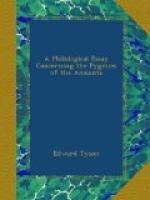China no longer, so far as we know, contains any representatives of this type, but Professor Lacouperie[A] has recently shown that they formerly existed in that part of Asia. According to the annals of the Bamboo Books, “In the twenty-ninth year of the Emperor Yao, in spring, the chief of the Tsiao-Yao, or dark pigmies, came to court and offered as tribute feathers from the Mot.” The Professor continues, “As shown by this entry, we begin with the semi-historic times as recorded in the ’Annals of the Bamboo Books,’ and the date about 2048 B.C. The so-called feathers were simply some sort of marine plant or seaweed with which the immigrant Chinese, still an inland people, were yet unacquainted. The Mot water or river, says the Shan-hai-king, or canonical book of hills and seas, was situated in the south-east of the Tai-shan in Shan-tung. This gives a clue to the localisation of the pigmies, and this localisation agrees with the positive knowledge we possess of the small area which the Chinese dominion covered at this time. Thus the Negritos were part of the native population of China when, in the twenty-third century B.C., the civilised Bak tribes came into the land.” In Japan we have also evidence of their existence. This country, now inhabited by the Niphonians, or Japanese, as we have come to call them, was previously the home of the Ainu, a white, hairy under-sized race, possibly, even probably, emigrants from Europe, and now gradually dying out in Yezo and the Kurile Islands. Prior to the Ainu was a Negrito race, whose connection with the former is a matter of much dispute, whose remains in the shape of pit-dwellings, stone arrow-heads, pottery, and other implements still exist, and will be found fully described by Mr. Savage Landor in a recent most interesting work.[B] In the Shan-hai-king, as Professor Schlegel[C] points out, their country is spoken of as the Siao-jin-Kouo, or land of little men, in distinction, be it noted, to the Peh-min-Kouo, or land of white people, identified by him with the Ainu. These little men are spoken of by the Ainu as Koro-puk-guru, i.e., according to Milne, men occupying excavations, or pit-dwellers. According to Chamberlain, the name means dwellers under burdocks, and is associated with the following legend. Before the time of the Ainu, Yezo was inhabited by a race of dwarfs, said by some to be two to three feet, by others only one inch in height. When an enemy approached, they hid themselves under the great leaves of the burdock (koro), for which reason they are called Koro-puk-guru, i.e., the men under the burdocks. When they were exterminated by the wooden clubs of the Ainu, they raised their eyes to heaven, and, weeping, cried aloud to the gods, “Why were we made so small?” It should be said that Professor Schlegel and Mr. Savage Landor both seem to prefer the former etymology.
[Footnote A: Babylonian and Oriental Record, vol. v.]
[Footnote B: Alone with the Hairy Ainu.]




